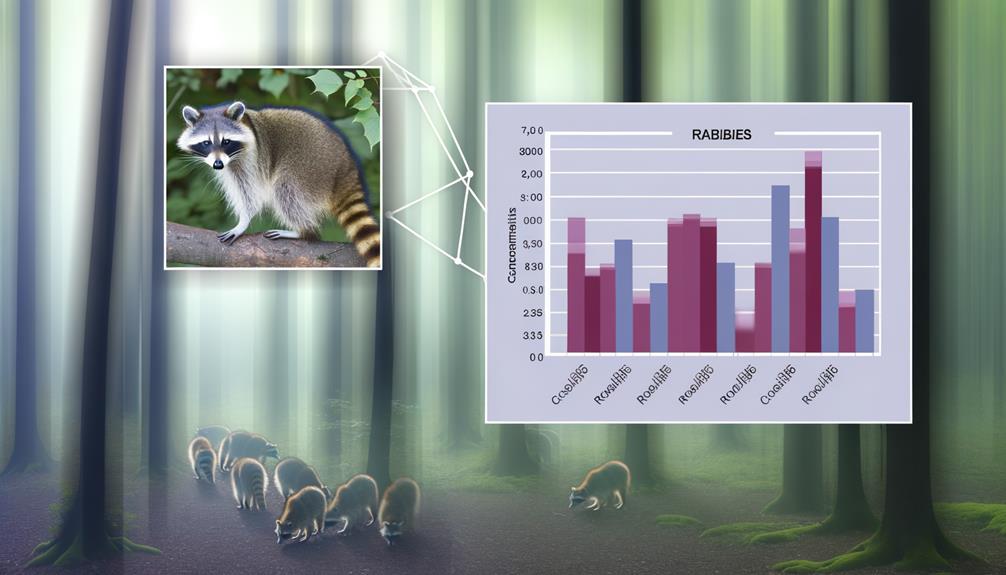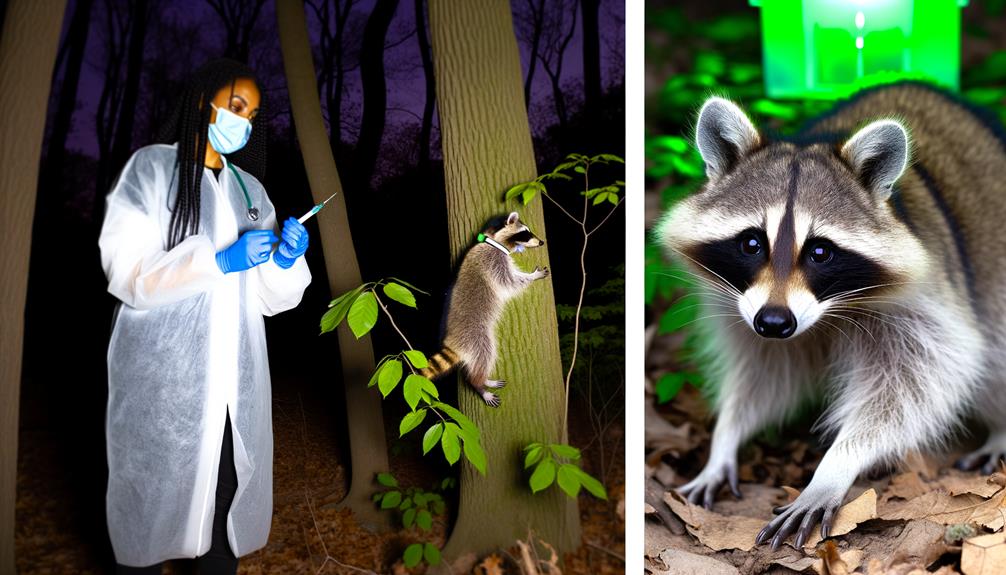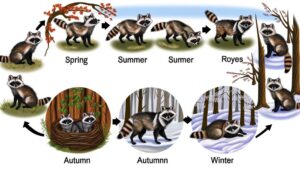Assessing the Common Risk of Rabies in Raccoons
Rabies is commonly found in raccoons, with these animals accounting for approximately 30% of all wildlife rabies cases in North America. The disease is particularly prevalent in the eastern United States, with high incidence rates reported in states such as New York, Pennsylvania, and Virginia.
Positivity rates in tested raccoon populations range between 10% and 20%. The density of raccoon populations and their proximity to human habitats increase transmission risks.
Regular monitoring, public education, and oral rabies vaccination programs are key to controlling its spread. For a deeper understanding of the regional impact and preventive measures, further details provide valuable insights.

Key Takeaways
- Raccoons account for approximately 30% of all wildlife rabies cases in North America.
- Rabies positivity rates in raccoons range from 10% to 20% in tested populations.
- The eastern United States, particularly the mid-Atlantic region, sees the highest incidence of raccoon rabies.
- Raccoon rabies cases have shown consistent presence over the past decade.
- High population density and habitat overlap with humans increase rabies transmission risk in raccoons.
Rabies in Raccoons: Statistics

According to recent epidemiological studies, raccoons are one of the primary wildlife reservoirs for rabies in North America, with reported cases accounting for approximately 30% of all wildlife rabies incidents. This significant percentage underscores the importance of monitoring raccoon populations in efforts to control rabies transmission.
Data from the Centers for Disease Control and Prevention (CDC) indicates that raccoon rabies cases have shown a consistent presence over the past decade, often peaking during specific seasons. The analysis reveals that rabies positivity rates in raccoons have ranged from 10% to 20% in tested populations.
These statistics highlight the pivotal role raccoons play in the epidemiology of rabies, necessitating continued surveillance and research to mitigate public health risks.
Geographic Distribution
The geographic distribution of rabies in raccoons spans mainly across the eastern United States, with particularly high incidence rates observed in states such as New York, Pennsylvania, and Virginia. Data from the Centers for Disease Control and Prevention (CDC) indicate that the mid-Atlantic region experiences the highest prevalence.
This pattern is attributed to both environmental factors and raccoon population densities. Moreover, specific hotspots have been identified through surveillance programs, which highlight the endemic nature of the disease in these areas.
The spread of rabies in raccoons is facilitated by their wide-ranging habitats, from urban to rural environments, complicating containment efforts. Understanding this distribution is critical for implementing targeted rabies control measures and preventing further geographic expansion.
Risk Factors

Multiple factors contribute to the risk of rabies transmission in raccoons, including population density, habitat overlap with humans and domestic animals, and environmental conditions that facilitate virus survival. High population density increases contact rates among raccoons, raising the likelihood of infection spread. Urban and suburban areas where raccoons and domestic animals cohabit elevate the risk of interspecies transmission. Environmental factors such as temperature and humidity can impact the virus's viability outside a host, further influencing transmission rates.
| Risk Factor | Impact on Rabies Transmission |
|---|---|
| Population Density | Higher contact rates among raccoons |
| Habitat Overlap | Increased interspecies transmission |
| Environmental Conditions | Enhanced virus survival outside host |
Understanding these risk factors is critical for developing targeted rabies control strategies.
Symptoms to Watch For
Recognizing the symptoms of rabies in raccoons is essential for early detection and effective management of the disease. Initial clinical signs often include behavioral changes such as increased aggression, unprovoked attacks, and nocturnal animals appearing during daytime.
Neurological symptoms may manifest as excessive salivation, difficulty swallowing, and progressive paralysis. Infected raccoons might also exhibit erratic movements, lethargy, and disorientation. According to data from the Centers for Disease Control and Prevention (CDC), these symptoms typically progress rapidly, leading to death within a few days to weeks post-onset.
Observing such symptoms warrants immediate caution and the involvement of animal control professionals to mitigate potential transmission risks to humans and other animals. Early identification is critical for public health safety.
Prevention and Control

Implementing effective prevention and control strategies for rabies in raccoons requires a multifaceted approach rooted in scientific research and public health policy. Central to these efforts is the deployment of oral rabies vaccination (ORV) programs, which have shown effectiveness in reducing rabies incidence among raccoon populations.
Data-driven models confirm that sustained ORV distribution can significantly reduce rabies transmission. Additionally, public education campaigns are crucial, educating communities about avoiding contact with wild raccoons and recognizing rabies symptoms.
Surveillance systems improve early detection, enabling prompt intervention. Finally, coordinated inter-agency collaboration ensures a thorough response, integrating wildlife management and public health directives to effectively mitigate the spread of rabies.
Conclusion
The prevalence of rabies in raccoons varies notably based on geographic distribution and local wildlife management practices.
A notable statistic is that raccoons account for approximately 30% of all rabies cases reported in the United States, underscoring their role as a key rabies vector.
Vigilance in monitoring and controlling raccoon populations, coupled with public education on recognizing symptoms and risk factors, is essential for mitigating the spread of this zoonotic disease.





